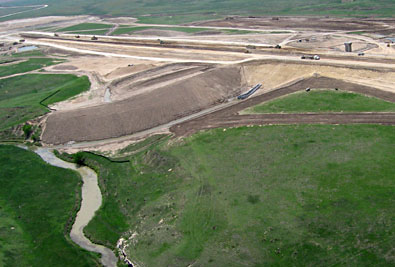
| Horse Thief Canyon
Dam and Reservoir
Hodgeman County, Kansas
J.S. and S.W. Aber
Brenda Zabriskie |
Introduction (2009)
Horse Thief Canyon dam is the newest large reservoir construction project underway in Kansas, located on Buckner Creek in Hodgeman County in the west-central part of the state. The dam and eventual lake are located next to K-156 state highway a few miles west of Jetmore. The project is funded by a special sales tax approved in 2005 by voters in four adjacent counties of the drainage basin—Hodgeman, Ford, Finney, and Gray. For more information, see Horse Thief Reservoir.
The authors have toured the surroundings before and have wanted to acquire KAP at this site for the past few years. Finally JSA was able to visit in mid-May '09 and conduct solo KAP under mostly clearly sky with a moderate breeze from the north. KAP took place at a small public viewing area on the northeastern corner of the construction site, so the kite carried toward the construction area. A small (11-foot) delta kite was used to lift the Canon S70 camera rig.
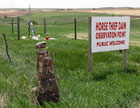
| A traditional stone fence post marks the public viewing area for construction of Horse Thief Canyon dam, which can be seen in the background. Also note the GPS survey station used for contruction measurements (detail to right).
| 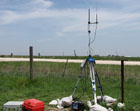
|
Buckner Creek is a spring-fed stream that arises along the margin of the High Plains (to the west) and flows eastward through the Blue Hills region. Ground water from the High Plains aquifer supplies the springs. In recent years, however, ground water has diminished due largely to pumping for irrigation, and recurring droughts have reduced surface stream flows. The long-term success of the lake is open to question given the small size of Buckner Creek and its drainage basin as well as limited surface and ground water in the semi-arid climate.
Dam and reservoir construction

| Left: overview toward the northwest. The project management office can be seen in the far distance next the K-156 state highway. Right: view toward southwest. The outlet tower connects under the dam to a new outlet chute on the left side.
|  |
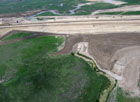
| Central dam construction. Overview (left) and close-up shot (right). The previous channel of Buckner Creek is now completely blocked by the dam. Buckner Creek can be seen in the background (behind dam), and the new outlet tower is visible behind the dam on left side.
| 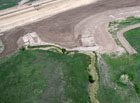 |

| Left: southern portion of the dam. Flow from the outlet chute connects to Buckner Creek channel on left side. Chalk bedrock is exposed along the old creek channel in lower left portion of scene. Right: view southeastward, looking downstream across Buckner Creek valley below the dam.
| 
|
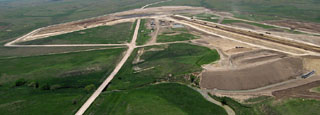
| Overview looking southward. The dam outlet appears on the right side. In the center distance is the emergency overflow spillway. The county road has been diverted around this spillway in the right background. May 2009.
| |
Update (2010)
In May 2010 officials announced that Horse Thief Canyon reservoir was filling faster than expected due to exceptionally heavy spring rain. The surface area of the lake had reached 60% of its eventual full size. Once again we visited (JSA & BZ) for kite aerial photography. We found the public viewing area had been removed and access to the site was completely blocked by construction and warning signs. Fortunately we found a public road along the northwestern side of the construction area where we could send up a large rokkaku kite with the Canon S70 camera rig.
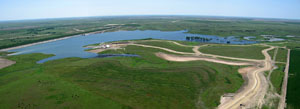
| Panoramic view looking southeastward at scene center. The dam appears in the left background, and Buckner Creek feeds into the reservoir from the right background. The boat ramp area is under construction just left of scene center. Assembled from two wide-angle shots; May 2010. | |
Lake full (2015)
After partial filling in 2010, the lake gradually declined during subsequent drought years. Many people believed the lake would never fill. The spring of 2015 was exceptionally wet, however, and repeated heavy rains during May led to significant runoff and local flash flooding that filled the reservoir to full capacity. Up to 10 inches of rain fell on parts of the drainage basin. The lake rose 11 feet overnight, and the floodgates were opened in the last week of May for the first time since the dam was constructed in 2009 (Hutchinson News).
The author (JSA) visited on May 31st and conducted solo KAP using two cameras, namely the radio-controlled Canon Elph and automatic Canon S70 rigs, lifted by a small rokkaku on a steady south breeze. Many visitors came by to view the full lake and watch the KAP.

| Left: looking eastward toward the dam in the distance and camping area in the foreground. Right: View to north showing the access road on right and agricultural fields to left.
|  |

| Views toward northwest over a terraced field of winter wheat. Water fills the swales behind each terrace, a rare sight in western Kansas.
|  |

| Left: looking across the lake to prominent bluffs on the southern side. Right: view westward showing meandering Buckner Creek as it enters the lake from upstream.
|  |

| Left: conducting kite aerial photography from the picnic area on the northern side of the lake. Right: testing the camera rig before launching with a self portrait (JSA).
| 
|
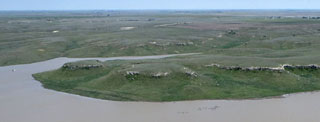
| Close-up view of bluffs along the southern side of the lake basin. The ledges are formed by mortar beds at the base of the Ogallala Formation, which underlies the High Plains. | |
During the past two years, drought conditions in central and western Kansas have diminished from extreme and exceptional categories. By the beginning of June 2015, in fact, drought was completely gone in the Horse Thief Canyon vicinity. May of 2015 was exceptionally wet across the southern Great Plains and Rocky Mountain regions (see statewide precipitation). In fact, May 2015 was the wettest month for the whole United States since records began in 1895 (NOAA 2015).
Reference
- NOAA 2015. National Overview – May 2015. NOAA, National Centers for Environmental Information. See online report.

 Return to KAP home or gallery.
Return to KAP home or gallery.
All text and imagery © by J.S. Aber.
Last update May 2018.



![]() Return to KAP home or gallery.
Return to KAP home or gallery.